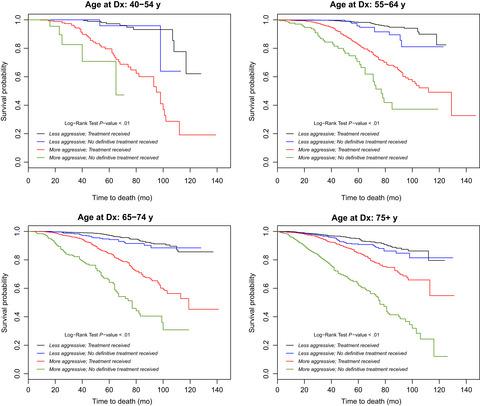当前位置:
X-MOL 学术
›
Cancer Med.
›
论文详情
Our official English website, www.x-mol.net, welcomes your
feedback! (Note: you will need to create a separate account there.)
Prostate cancer in Pennsylvania: The role of older age at diagnosis, aggressiveness, and environmental risk factors on treatment and mortality using data from the Pennsylvania Cancer Registry.
Cancer Medicine ( IF 2.9 ) Pub Date : 2020-03-25 , DOI: 10.1002/cam4.3003 Shirley M Bluethmann 1, 2 , Ming Wang 1, 2 , Emily Wasserman 1 , Chixiang Chen 1 , Nicholas G Zaorsky 1, 2 , Raymond J Hohl 1, 2 , Alicia C McDonald 1, 2
Cancer Medicine ( IF 2.9 ) Pub Date : 2020-03-25 , DOI: 10.1002/cam4.3003 Shirley M Bluethmann 1, 2 , Ming Wang 1, 2 , Emily Wasserman 1 , Chixiang Chen 1 , Nicholas G Zaorsky 1, 2 , Raymond J Hohl 1, 2 , Alicia C McDonald 1, 2
Affiliation

|
BACKGROUND
To assess: (a) cancer treatment in prostate cancer survivors (PCS) by age at diagnosis (ADx) and prostate cancer (PC) aggressiveness; (b) potential impact on PC mortality; and (c) these results in the context of environmental/behavioral risk factors on PCS in Pennsylvania.
METHODS
Prostate cancer survivors ages ≥40 years were identified from the 2004-2014 Pennsylvania Cancer Registry (PCR). Demographic/clinical descriptors and PC treatment were extracted from PCR. Prostate cancer aggressiveness was defined by clinical/pathologic Gleason score and tumor stage. Logistic and Cox regression analyses tested associations between treatment received and PC-specific mortality. County-level data from the Pennsylvania BRFSS were used to estimate cancer-related behavioral risk factors (eg, smoking, physical inactivity, fruit/vegetable consumption [FV], alcohol use) and used as covariates.
RESULTS
There were 90 694 PCS ages 40-105 years (mean age = 66.19 years, SD = 9.25) included. Most were non-Hispanic white men (83%). Prostate cancer survivors ≥75 years were least likely to receive any treatment but men ages 65-74 were more likely to receive combined therapies (OR = 1.47; 95% CI 1.28, 1.69) vs PCS ages 40-54 years, controlling for covariates. Prostate cancer survivors 55-75+ with aggressive PC who received any treatment vs no definitive treatment had significantly reduced mortality. Men from counties with high obesity and smoking rates were significantly less likely to receive any treatment than men living in counties with lower rates of these risk factors. Prostate cancer survivors who lived in counties with high rates of physical inactivity and had high rates of sufficient FV consumption were slightly more likely to receive cancer treatment vs no definitive treatment compared to men who lived in counties with high rates of physical activity and lower FV consumption.
CONCLUSIONS
We observed a general age-related decline in receipt of treatment. Prostate cancer survivors ages ≥75 years were significantly less likely to get any cancer treatment compared to younger PCS. However, most men with more aggressive disease who received any treatment had greatly reduced PC mortality, regardless of age. Considering environmental/behavioral risk factors may attenuate PC risk and inform treatment options.
中文翻译:

宾夕法尼亚州的前列腺癌:使用宾夕法尼亚癌症登记处的数据,年龄较大在诊断中的作用、侵袭性和环境风险因素对治疗和死亡率的影响。
背景 评估: (a) 根据诊断年龄 (ADx) 和前列腺癌 (PC) 侵袭性对前列腺癌幸存者 (PCS) 进行的癌症治疗;(b) 对 PC 死亡率的潜在影响;(c) 这些结果与宾夕法尼亚州 PCS 的环境/行为风险因素有关。方法 从 2004-2014 年宾夕法尼亚癌症登记处 (PCR) 中确定年龄≥40 岁的前列腺癌幸存者。从 PCR 中提取人口统计学/临床描述符和 PC 治疗。前列腺癌侵袭性由临床/病理 Gleason 评分和肿瘤分期定义。Logistic 和 Cox 回归分析测试了接受的治疗与 PC 特异性死亡率之间的关联。宾夕法尼亚州 BRFSS 的县级数据用于估计与癌症相关的行为风险因素(例如,吸烟、缺乏身体活动、水果/蔬菜消费 [FV]、饮酒)并用作协变量。结果 共纳入 90 694 名年龄在 40-105 岁之间的 PCS(平均年龄 = 66.19 岁,SD = 9.25)。大多数是非西班牙裔白人男性 (83%)。≥75 岁的前列腺癌幸存者最不可能接受任何治疗,但 65-74 岁的男性更有可能接受联合治疗(OR = 1.47;95% CI 1.28, 1.69)与 40-54 岁的 PCS 相比,控制协变量。55-75 岁以上患有侵袭性 PC 的前列腺癌幸存者接受任何治疗与未接受明确治疗相比,死亡率显着降低。与生活在这些危险因素发生率较低县的男性相比,来自肥胖和吸烟率高的县的男性接受任何治疗的可能性要小得多。与生活在身体活动率高且 FV 消耗量较低的县的男性相比,居住在缺乏身体活动率高且 FV 消耗量高的县的前列腺癌幸存者接受癌症治疗的可能性略高于未接受最终治疗的男性. 结论 我们观察到接受治疗的普遍年龄相关性下降。与年轻的 PCS 相比,年龄≥75 岁的前列腺癌幸存者接受任何癌症治疗的可能性显着降低。然而,无论年龄大小,大多数患有更严重疾病的男性在接受任何治疗后都大大降低了 PC 死亡率。考虑环境/行为风险因素可能会降低 PC 风险并告知治疗方案。
更新日期:2020-03-25
中文翻译:

宾夕法尼亚州的前列腺癌:使用宾夕法尼亚癌症登记处的数据,年龄较大在诊断中的作用、侵袭性和环境风险因素对治疗和死亡率的影响。
背景 评估: (a) 根据诊断年龄 (ADx) 和前列腺癌 (PC) 侵袭性对前列腺癌幸存者 (PCS) 进行的癌症治疗;(b) 对 PC 死亡率的潜在影响;(c) 这些结果与宾夕法尼亚州 PCS 的环境/行为风险因素有关。方法 从 2004-2014 年宾夕法尼亚癌症登记处 (PCR) 中确定年龄≥40 岁的前列腺癌幸存者。从 PCR 中提取人口统计学/临床描述符和 PC 治疗。前列腺癌侵袭性由临床/病理 Gleason 评分和肿瘤分期定义。Logistic 和 Cox 回归分析测试了接受的治疗与 PC 特异性死亡率之间的关联。宾夕法尼亚州 BRFSS 的县级数据用于估计与癌症相关的行为风险因素(例如,吸烟、缺乏身体活动、水果/蔬菜消费 [FV]、饮酒)并用作协变量。结果 共纳入 90 694 名年龄在 40-105 岁之间的 PCS(平均年龄 = 66.19 岁,SD = 9.25)。大多数是非西班牙裔白人男性 (83%)。≥75 岁的前列腺癌幸存者最不可能接受任何治疗,但 65-74 岁的男性更有可能接受联合治疗(OR = 1.47;95% CI 1.28, 1.69)与 40-54 岁的 PCS 相比,控制协变量。55-75 岁以上患有侵袭性 PC 的前列腺癌幸存者接受任何治疗与未接受明确治疗相比,死亡率显着降低。与生活在这些危险因素发生率较低县的男性相比,来自肥胖和吸烟率高的县的男性接受任何治疗的可能性要小得多。与生活在身体活动率高且 FV 消耗量较低的县的男性相比,居住在缺乏身体活动率高且 FV 消耗量高的县的前列腺癌幸存者接受癌症治疗的可能性略高于未接受最终治疗的男性. 结论 我们观察到接受治疗的普遍年龄相关性下降。与年轻的 PCS 相比,年龄≥75 岁的前列腺癌幸存者接受任何癌症治疗的可能性显着降低。然而,无论年龄大小,大多数患有更严重疾病的男性在接受任何治疗后都大大降低了 PC 死亡率。考虑环境/行为风险因素可能会降低 PC 风险并告知治疗方案。











































 京公网安备 11010802027423号
京公网安备 11010802027423号